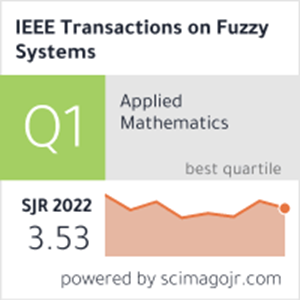认知无线大数据中自动调制识别的深度图形和时态神经模糊方法
IF 10.7
1区 计算机科学
Q1 COMPUTER SCIENCE, ARTIFICIAL INTELLIGENCE
引用次数: 0
摘要
随着大数据技术的发展,深度学习自动调制识别(DLAMR)有了新的发展。现有的DLAMR方法主要关注模型本身或无处不在的大通信数据的初级匹配,缺乏可解释性,忽略了对通信信号调制机制的深度表征;因此,在复杂的通信环境下,进一步提高识别精度和多象限调幅(MQAM)的可分辨性遇到了困难。针对这些挑战,本文提出了一种创新的通信信号图映射方法来解决调制机制中的不确定性。具体来说,它将采样点建模为节点;用边连接符号间点和符号内点,表示调制机制和传播不确定性;并将振幅、相位、同相和正交值映射为节点特征。在此基础上,提出了一种融合了图形注意网络和双向长短期记忆网络的深度图形和时间神经模糊方法(GT-DNFS)。数值结果表明,GT-DNFS的识别准确率达到了93.01%,MQAM (M= 16,64)的识别率达到了94.5%。该研究为神经模糊网络和高效的DLAMR算法设计提供了有价值的见解。本文章由计算机程序翻译,如有差异,请以英文原文为准。
Deep Graphical and Temporal Neuro-Fuzzy Methodology for Automatic Modulation Recognition in Cognitive Wireless Big Data
With the advancement of Big Data technology, deep learning automatic modulation recognition (DLAMR) has undergone new improvements. Existing DLAMR methods focus mostly on the primary matching of the model itself or ubiquitous big communications data, which lack interpretability and ignore deep representations for the modulation mechanism of the communication signals; thus, difficulties in further improving the recognition accuracy and multiquadrant amplitude modulation (MQAM) discriminability in complex communication environments are encountered. In response to these challenges, this article proposes an innovative communication signal graph mapping method to address the uncertainty in the modulation mechanisms. Specifically, it models sampling points as nodes; connects inter- and intrasymbol points with edges to represent modulation mechanisms and propagation uncertainty; and maps amplitude, phase, in-phase, and quadrature values as node features. A deep graphical and temporal neuro-fuzzy methodology (GT-DNFS) that integrates graph attention networks and bidirectional long short-term memory networks is subsequently proposed for DLAMR. The numerical results show that GT-DNFS achieves a significantly higher recognition accuracy of 93.01%, and an MQAM (M=16, 64) discrimination of 94.5%. This research offers valuable insights for neuro-fuzzy networks and efficient DLAMR algorithm design.
求助全文
通过发布文献求助,成功后即可免费获取论文全文。
去求助
来源期刊

IEEE Transactions on Fuzzy Systems
工程技术-工程:电子与电气
CiteScore
20.50
自引率
13.40%
发文量
517
审稿时长
3.0 months
期刊介绍:
The IEEE Transactions on Fuzzy Systems is a scholarly journal that focuses on the theory, design, and application of fuzzy systems. It aims to publish high-quality technical papers that contribute significant technical knowledge and exploratory developments in the field of fuzzy systems. The journal particularly emphasizes engineering systems and scientific applications. In addition to research articles, the Transactions also includes a letters section featuring current information, comments, and rebuttals related to published papers.
 求助内容:
求助内容: 应助结果提醒方式:
应助结果提醒方式:


